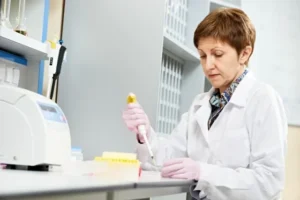
Paternity testing is a scientific method for proving family ties between a parent and child based on genetic kinship. This test is revolutionary in many fields, especially in family law.
Until around fifty years ago, there was no practical way to prove paternity. Following the amazing discoveries of modern biology, primarily DNA and heredity, paternity can now be proved with almost absolute certainty.
The genetics of paternity testing
DNA is inherited from both our parents. Our genetic code is “packaged” in forty-six units called chromosomes. The chromosomes are arranged in twenty-three pairs, each pair contains one chromosome from our mother and one from our father.
Germ cells (the egg and sperm) only contain half of the parent’s genetic material – one chromosome of each kind. During fertilization, half of the genetic material necessary for creating the embryo originates from the father and the other half originates from the mother.
Although people have very similar genetic material, there are still many differences that distinguish them from each other. These genetic differences can be in longer segments of DNA, in repetitive DNA sequences, or in a single base-pair.
Single nucleotide polymorphisms (also known as SNPs) usually serve as the base for testing genetic markers. The vast knowledge accumulated about the genetic difference between people in certain points in the DNA allows different people to be distinguished based on changes in their genetic material.
Matches between the genetic markers of a father and his child (in half the chromosomes) constitute a positive result in a paternity test.
Testing enough points helps reduce the risk for errors. It should be noted that in some cases, there is not a complete match between the markers of the parent’s chromosomes and the child’s chromosomes due to a phenomenon known as translocations. Chromosome translocations are an exchange of genetic material between chromosomes during duplication. These changes should be considered during genetic testing.
How is the test performed?
To perform a paternity test, cell samples are taken from the child (or fetus), the alleged father, and sometimes also from the mother. When the need to prove paternity arises during pregnancy, the test can be performed via amniocentesis or chorionic villus sampling (CVS). In these methods, samples of cells are taken from the fetus and the placenta (the genetic material of the placenta is usually identical to that of the fetus). However, these tests carry a small risk for miscarriage.
The samples used to test the father’s genetic material can be of different sources since almost all cells contain identical DNA. In most cases, blood samples (containing leucocytes) or saliva samples are used.
The samples taken from the father are tested for different genetic markers. These markers are crossed with those taken from the child (and mother). This simple crossing allows finding matches between the father and child’s genetic material. During testing, translocations are also considered. This test can be used to prove both paternity and maternity.
How accurate is a paternity test?
Like any other medical examination, paternity testing is never 100% certain. However, modern paternity tests have a very low inaccuracy rate. The chances of a random person, who is not the father, to carry similar genetic markers to the child being tested depends on the number of markers being tested.
When the number of markers is nine or more, the chance for errors is extremely low. Identical twins have the same genetic profile and therefore cannot be distinguished by a paternity test.
A legal paternity test is admissible in court for different purposes, such as deciding on child support.

